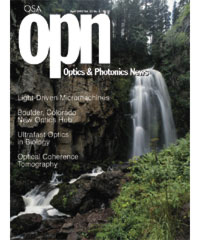
April 2002 Issue
Feature Articles
Boulder Emerges as New Optics Hub in the West
Boulder, Colorado, was an emerging center for optics and optics-based research even before two Boulder scientists shared last year’s Nobel Prize in physics for their work on Bose-Einstein condensation. During the past twenty years, the city has become a magnet for optics engineers and scientists. “None of my students ever seem to leave,” says Carl Wieman, one of the Nobel laureates and a professor at the University of Colorado at Boulder. Instead, they move into research, start companies, or take up positions at one of the many high-tech optics businesses that have grown up locally or moved into the area.
by Michael WenyonEmerging Clinical Applications of Optical Coherence Tomography
Optical coherence tomography (OCT) is an emerging noninvasive imaging technique that provides microscopic tomographic sectioning of biological samples. By measuring backscattered light as a function of depth, OCT fills a valuable niche in imaging of tissue microstructure, providing subsurface imaging with high spatial resolution (on the order of ten micrometers) in three dimensions and high sensitivity in vivo with no contact needed between the probe and the tissue.
by Andrew M. Rollins, Michael V. Sivak, Jr., SunitaImaging the Cardiovascular System with Optical Coherence Tomography
Myocardial infarction, commonly known as a heart attack, is a leading cause of death worldwide. It was once believed that large plaques within the coronary arteries caused heart attacks. Since the mid 1980s, however, it has become apparent that heart attacks occur from the rupture of small plaques in the coronary arteries. When these plaques rupture, they release lipids into the blood stream. A clot forms, and the vessel occludes.
by Mark Brezinski and James FujimotoLight-Driven Micromachines
It isn’t uncommon for scientists to be inspired by science fiction, and good science fiction has a strong basis in real science. Modern science fiction is well populated with “nanobots” and “microbots,” tiny robots that are injected into the bloodstream where they perform tasks ranging from repairing damage and curing diseases to controlling human thoughts and actions. The miniature robot concept may seem far-fetched today, yet technological advances in the area of micromachine research are bringing the possibility of devices like this much closer to reality.
by Halina Rubinsztein-Dunlop and Marlies E.J. FrieseOptical Coherence Tomography of the Retina
Although the question of why the pupil is black had attracted the attention of writers dating back to the time of Ancient Rome, it was not until 1851 that Herman Ludwig von Helmholtz unlocked the door to the back of the eye by inventing the Augenspiegel, or ophthalmoscope. Von Helm-holtz’s groundbreaking invention enabled examination of both normal and diseased eyes. It also allowed drawings to be made of the fundus. The first images of the retina were useful to physicians for communicating both normal and unusual findings to their colleagues.
by Hazem Rashed, Joseph Izatt, and Cynthia TothUltrafast Optics
Ultrafast lasers have matured to the point that scientists unfamiliar with ultrafast technology can purchase reliable “plug-and-play” lasers for application in their own areas of expertise. These next-generation sources, which eliminate the need for users to become intimately acquainted with ultrafast optics, have significantly broadened the application base of ultrafast lasers. No-where is this trend more evident than in the application of ultrafast science to biology and medicine.
Departments and Columns
H-1B Visa Reforms Debated in Congress
Legislation to reform the H-1B visa program, which allows companies and university research centers to recruit foreigners with Ph.D. degrees in physics and engineering for job vacancies for which there are no U.S.-born applicants, is expected to be introduced in Congress.
Doppler Shift, Stellar Aberration, and Convection of Light by Moving Media
In this article we derive general formulas for Doppler shift, stellar aberration, and convection of light by moving media by applying the Lorentz transformation to a plane electromagnetic wave.
Launching a New Laser Center in Africa
A network to promote the application of laser-based technologies in fields ranging from the environment to health care is slated to be launched in Africa this summer.
An Executive Office for OSA
The Optical Society of America, founded in 1916, boasts an exciting history intertwined with many of the key scientific advances of the 21st century. John N. Howard, from 1960 until 1987 the editor of Applied Op- tics, has agreed to highlight some key moments in OSA history in a new OPN column.
Parting Words...
The “Legal Lens” column was launched in January 1998 with the goal of introducing OPN readers to the little-explored and oft-misunderstood legal threads that course through the world of optics and other high-technology industries. Four and a half years and some fifty columns later, I think I’ve written enough, and you’ve probably read enough.
New OSA Education Web Site: OpticsForKids.org
OSA has a strong tradition of education outreach, embodied in its 17-year sponsorship of Educator’s Day and in the development of the OSA Optics Discovery Kit, designed to illustrate basic optics principles to the pre-college community. This year, OSA is proud to launch one of its most aggressive outreach initiatives to date: OpticsForKids.org.


![A multiplexed image of a human tonsil acquired. [NIAID] using the iterative bleaching extends multiplexity (IBEX) method.](https://opnmedia.blob.core.windows.net/$web/opn/media/images/articles/2024/0424/departments/202404-cover-web.jpg?ext=.jpg)
